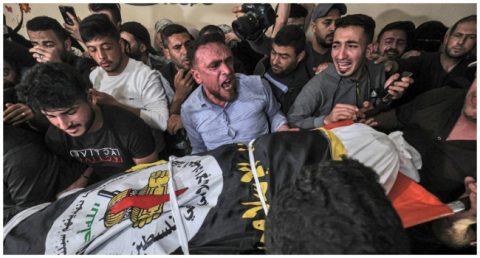Mass Grave Dug At Gaza Hospital As Humanitarian Catastrophe Grows
Latest Headlines, World News Tuesday, November 14th, 2023
(AFRICAN EXAMINER) – The catastrophic humanitarian situation in the Gaza Strip grew worse on Tuesday as much of the focus remained on grim accounts about the state of the collapsed health system after almost six weeks of war between Israel and Gaza’s Hamas rulers.
UN Secretary General António Guterres said he was “deeply disturbed” by the perilous situation at Gaza’s hospitals and, “in the name of humanity,” called for a ceasefire.
Another dire warning came from the UN’s Palestinian relief agency, which said humanitarian operations were grinding to a halt due to the lack of fuel.
In northern Gaza, there was fierce fighting between Israeli soldiers and Palestinian militants around several hospitals.
Attacks on hospitals and a lack of fuel to generate electricity have claimed the lives of several patients in recent days, including newborn babies, according to Palestinian and UN officials.
Around 180 decomposing bodies on the grounds of al-Shifa, the largest hospital in the Gaza Strip, have begun to be buried in a mass grave in a courtyard, according to the Hamas-controlled Ministry of Health.
The account could not immediately be verified.
However, it accorded with descriptions of the situation by the UN’s Office for the Coordination of Humanitarian Affairs (OCHA), which said on Monday it had heard of about 100 bodies that could not be buried at the hospital.
The World Health Organisation (WHO) said on Tuesday that al-Shifa Hospital was still in operation, contrary to statements made by health officials at the weekend.
“We call it a functioning hospital because of the heroic efforts of the staff remaining,” WHO spokeswoman Margaret Harris said in Geneva on Tuesday.
Despite the lack of power and attacks, the staff at al-Shifa Hospital are trying everything they can to care for around 700 remaining seriously ill patients. Within the past 24 hours, 20 of those have died, Harris said, referring to figures from the local health authorities.
The WHO has its own staff in the north of the Gaza Strip, said Harris.
Like the remaining population, they were having problems getting the basic necessities of food and drink.
The al-Shifa Hospital is not only the largest in the Gaza Strip.
Before the recent Israeli attacks, it was also the best-equipped hospital with the most specialised doctors where the seriously ill patients were treated.
Evacuating them would have been difficult even under the best conditions without conflict in the streets, said Harris, but it was impossible in the chaos of the conflict.
In addition, there is no capacity in the south of the Gaza Strip to receive these patients.
“We are begging for a ceasefire,” Harris said.
Street fighting in Gaza City is also preventing emergency workers from responding to calls for help from people trapped under rubble after Israeli bombardments.
People who can no longer get out of their homes and those who need ambulances for the wounded often wait in vain, OCHA reported, citing the Palestinian Red Crescent.
Israel says Hamas is using medical facilities and civilians as “human shields,” with terrorists operating command centres in or under hospitals, including al-Shifa, making them legitimate targets.
On Monday, the Israeli Defense Forces (IDF) said Hamas weapons and explosives were found at al-Rantisi Children’s Hospital after the site was evacuated on Sunday.
Almost 1.6 million of the approximately 2.3 million inhabitants of the sealed-off Gaza Strip have been displaced since the start of the Israeli attacks on Oct. 7. Many have taken shelter in hospitals.
Israel’s offensive was prompted by massacres carried out by Hamas and other militants in Israel, which killed about 1,200 people.
The groups also kidnapped around 240 people and took them to Gaza.
Three people were injured in Tel Aviv on Tuesday after militants in Gaza once again fired rockets at the city. The city was last targeted by rockets from the Palestinian territory on Friday.
The number of Palestinians killed in Gaza has risen to 11,500 since the start of the war on October 7, according to the Hamas-run Health Ministry in Gaza. Some 29,000 people have been injured.
The UN’s main agency in the Gaza Strip said late Tuesday that humanitarian operations were ending due to the lack of fuel.
Israel has not allowed fuel into the territory due to fears it could be used by Hamas fighters.
“The humanitarian response in the Gaza Strip, on which over 2 million people depend, is gradually coming to an end because no fuel has been allowed into the Gaza Strip since October 7,” UNRWA Commissioner-General Philippe Lazzarini said in a statement.
“It is very simple. Without fuel, the humanitarian operation in Gaza is coming to an end. Many more people will suffer and will likely die,” he said.
The push to free the hostages held by Hamas has made little progress.
The International Committee of the Red Cross (ICRC) said on Tuesday it still had not been granted access by Hamas to see them.
“We have been insisting to see the hostages,” spokeswoman Fatima Sator said in Geneva on Tuesday.
“It is part of our dialogue with Hamas,” she added.
Angry relatives and friends of the hostages are marching almost 70 kilometres from Tel Aviv to Jerusalem, where they are set to arrive on Sunday.
There, they are to march to the official residence of Prime Minister Benjamin Netanyahu, according to organisers.
Only four hostages have been released and one was freed in a military operation.
It is unclear how many of the others are still alive. (dpa/NAN)
Related Posts
Short URL: https://www.africanexaminer.com/?p=92209






















